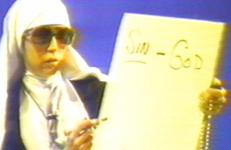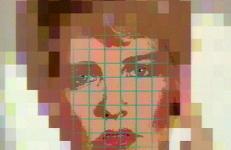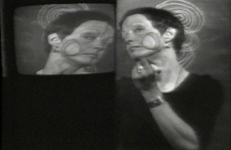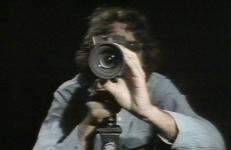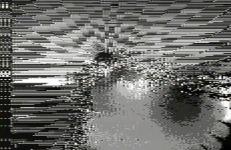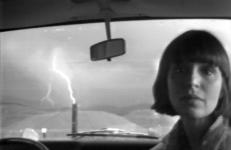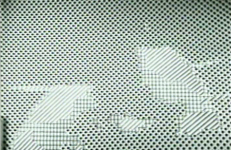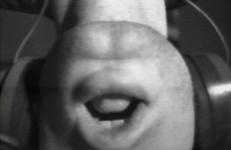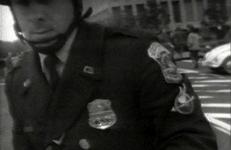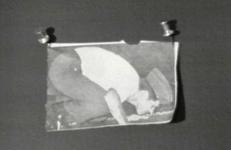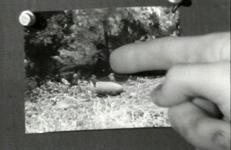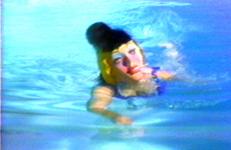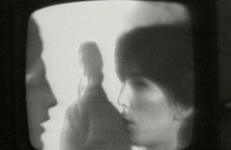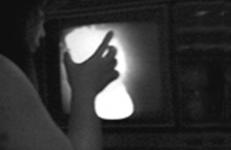A classic feminist video, Learn Where the Meat Comes From depicts how “gourmet carnivore tastes take on a cannibalistic edge. This parody of a Julia Child cooking lesson collapses the roles of consumer and consumed: Lacy instructs us in the proper butcher’s terms for cuts of meat by pointing them out on her body. As the lesson progresses she becomes more and more animal-like, growling and baring over-sized incisors. Perhaps, in her role as a gourmet cook, she is herself as much consumed as consumer.”
Video History
This video is related to Seven Years of Living Art (a seven-year performance of personal endurance Montano began in December of 1984) and adopts the Zen Chakra system of seven centers as a structuring device. The adoption of the Chakra system arises from Montano’s commitment to the study of Eastern culture and religion.
Believing that we are, "dragging our feet into the 21st Century," Almy made this video trilogy to celebrate technology and the future in an ironic melange of politics, sociology, sexuality, and economics. Flawlessly melding sound and image, the video moves through three sections, "Countdown," "Departure," and "Arrival." In the end, Almy posits this paradox: technology as a human development is rapidly making humans obsolete and interpersonal contact impossible, making the future of man’s presence and very existence uncertain.
“In Left Side Right Side, Jonas explores the ambiguities caused by her attempt to identify correctly the spatial orientation of images simultaneously played back by a monitor and reflected in a mirror. This is confusing because, contrary to what one might expect, the monitor image gives back a ‘true’ reading of the space while the mirror reverses it.… Throughout the course of the tape, the image switches back and forth between the double image of monitor and mirror to the simple ‘real’ image of Jonas’s face.”
Produced in Liege for Belgium TV, this tape considers how broadcast television functions in a multi-lingual area. A televised Tower of Babble, Muntadas shows the rigid conformity of style and content enforced through the medium, drawing attention to the similiar format of the programs broadcast in different languages.
"Real time digital buffer recording, light bulb, panning camera motor and turntable. Light Bulb, the title says it almost all. Real time recording events. Two cameras, light bulb, camera panning motor, electric lazy susan, spinning white paper rectangle for the clip. Using the first digital video frame buffer I built together with David Jones, video buffer number one with variable clock. Several minutes of Rube Goldberg like digital electronics and optical props and motors. No computer, just entergetic digital slivers, shimmering and shattering."
– Peer Bode
When I look for the lightning, it never strikes. When I look away, it does. Filmed inside a car, this tape focuses on observation of natural phenomena, presenting the obverse of the, "If a tree falls in the woods..." conundrum. Does observation change the course of events? Can you believe in things you don't see? In this experiment, the camera occupies a privileged position — showing the woman and what she sees, as well as what she cannot see.
When I look for the lightning, it never strikes. When I look away, it does. Filmed inside a car, this tape focuses on observation of natural phenomena, presenting the obverse of the, "If a tree falls in the woods..." conundrum. Does observation change the course of events? Can you believe in things you don't see? In this experiment, the camera occupies a privileged position — showing the woman and what she sees, as well as what she cannot see.
Lines of Force opens with footage of a dramatic explosion. For most of the piece, the screen is divided, into a triptych at first, and slowly into horizontal and vertical bars. Electronically manipulated footage shows a man walking, a marching band, ferns, cartoons, a window, and a train arriving on a set of tracks. The naturally occurring lines in the array of images presented mirror the electronically created bars and lines that divide the screen. Natural scenes provide a respite from the frantic pace of the images.
An upside-down close-up of the artist’s mouth, Nauman repeats the words “lip sync” as the audio track shifts in and out of sync with the video. The disjunction between what is seen and heard keeps the viewer on edge, struggling to attach the sound of the words with the off-kilter movements of Nauman’s mouth.
This title was in the original Castelli-Sonnabend video art collection.
Tripping out on loneliness, The Loner drifts through one daydream about “Her” after another. Oursler nightmarishly fantasizes about the dismal prospect of looking for love in a sleazy singles bar. Painfully aware of his lack, the hero is moved by his constant misrecognition of the object of his desire in an adolescent melodrama of sexual obsession and failure. As one of Oursler’s earliest tapes, The Loner is especially crude in its details, with many of the hand-painted sets dissolving under a stream of water.
Sixteen-year-old guru Marahaj Ji attempts to levitate the Houston Astrodome in this 1973 DuPont award winning documentary. Follow the guru from his New York mansion to limousines in Houston and listen to his followers—celebrities and non-celebrities alike—extol his virtues. TVTV's creative use of graphics, live music, and wide-angle-lens shots to conveys the desperate efforts of these lost children to find a leader.
"If this guy is God, then this is the God the United States of America deserves." —Abbie Hoffman
Treating the problem of anorexia nervosa from the parents' perspective, Rosler presents a mother and father speaking about the tragedy of their daughter's death as a result of dieting. The conversation turns toward the irony of self-starvation in a land of plenty and toward the international politics of food, where food aid is used as a negotiating tool. Confronting a serious issue, Rosler simultaneously sets into play the confessional form and the ghoulish staginess of talk show dramatics.
As a verite documentation of the May 1, 1971 demonstration against the Vietnam War staged in Washington, D.C., Mayday Realtime presents a largely unedited flow of events from the point of view of participants on the street. Cort's camera captures the random, disorienting incidents that marked the day - demonstrators holding up traffic in the Capitol, skirmishes with police, on-the-scene interviews with onlookers. The camera impulsively responds to shouting and movement on the street.
As a verite documentation of the May 1, 1971 demonstration against the Vietnam War staged in Washington, D.C., Mayday Realtime presents a largely unedited flow of events from the point of view of participants on the street. Cort's camera captures the random, disorienting incidents that marked the day - demonstrators holding up traffic in the Capitol, skirmishes with police, on-the-scene interviews with onlookers. The camera impulsively responds to shouting and movement on the street.
Baldessari asks Ed Henderson to discuss the meaning of selected news photos. Henderson invents the conditions of the where, when, and why each was taken—and decides whether the photo was altered in any way. This exercise complicates the reception of news media images and encourages a more analytical attitude towards the implicit meaning, and potentially faked reality, of such images.
This title was in the original Castelli-Sonnabend video art collection.
Baldessari presents photographs to his friend Ed Henderson and asks him to reconstruct the meaning of the image. In each case, Baldessari's strategy is to appropriate an existing image and remove it from its context in order to deconstruct the process of interpretation, and call the supposed objectivity of interpretation into question. The tape implicates the viewer in Ed Henderson's groundless exegesis, as he hypothesizes about the meaning of several photographs, speculating on their actual or staged reality.
Using performance as a means of personal transformation and catharsis, Mitchell’s Death mourns the death of Montano’s ex-husband. Every detail of her story, from the telephone call announcing the tragedy, to visiting the body, is chanted by Montano as her face, pierced by acupuncture needles, slowly comes into focus then goes out again. The chanting is reminiscent of Buddhist texts, while the needles signify the pain that is necessary for healing and understanding.
Originally presented as a live performance piece using actors, multiple monitors, and music, Modern Times is a consolidation of seven short chapters in the life of a modern woman. In the first sequence, the objects in a suburban home are inventoried: "nice couch," "nice car," and so on — ending with the titles "nice concept," "nice image" — and unmasking this materialistic world as an impossible consumer fantasy. In the next scene, an attractive man sunbathes.
Segalove takes her mom as subject in these short pieces, recording her stories, her advice, and her daily routine. What results is a portrait of a contemporary mother-daughter relationship, touchingly devoid of drama and full of whimsical humor. For example, in one piece, Ilene’s mother laments over a pair of shoes her daughter has chosen to hang on the wall instead of wearing, saying,”With you, everything is art.” In another segment the camera focuses on a pair of unoccupied, overstuffed chairs.
Taped on Prince Street in Soho, New York City, Skip Blumberg creates a one-word performance. Shouting the word "money" over and over, he attracts the attention of New York's finest. The video crew attempt to explain to the policemen that there is no public disorder as the streets were empty when they began to tape.
The video is an unwitting early example of the reaction of the state to the use of video cameras on the streets.
Part of an ongoing video correspondence with sculptor Robert Morris, Mumble brings together repeated scenes and gestures, featuring Morris and Jim Benglis (the artist's brother), and a narrative of irrelevant, confusing, and often purposefully untrue, statements. Although the viewer is inclined to accept Benglis's narrative as true, such trust is called into question by her statements about actions taking place off-camera — actions that cannot be verified.
Characteristic of much of Gillette's work—which treats video as a field of light, movement and reflection—Muse extends beyond optical sensation to engage the viewer in metaphysical contemplation. The dilemma of human rationality in the face of nature's unswerving course is stated by the narrator: "This is senseless. Shall I make sense or tell the truth? Choose either—I cannot do both...
In Music on Triggering Surfaces, Bode constructs an interface between audio and video systems. The luminance information (voltage) from the visual images traversed by the black dot is routed to an oscillator to produce the audio signal, which varies according to the changing luminance. The video image itself then triggers the audio. The shifting grey-scale of the image becomes a two-dimensional sound map or audio score. This tape was produced at the Experimental Television Center.
In this classic personal elegy, Kubota mourns her father's death and recounts the last days of his life. Reflecting on Kubota's use of the video medium, the television emerges as the link between Kubota and her father, with the melodramatic crooning of Japanese pop singers providing a backdrop for Kubota's real-life tragedy.
This title is also available on Surveying the First Decade: Volume 1.





